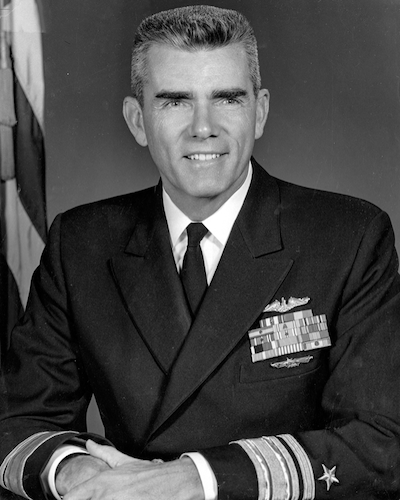Presidents Biographies - Dudley Knox Library
VADM Ann E. Rondeau (Ret.) 2019 -
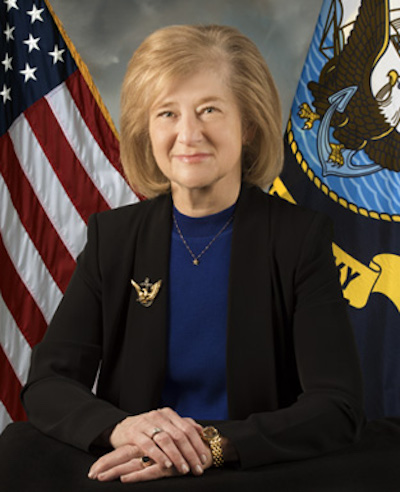
Retired Vice Adm. Ann E. Rondeau was appointed as President, Naval Postgraduate School on January 29, 2019. She brings to the assignment an unparalleled record of leadership and achievement within the military and academia in the areas of education, training, research, executive development, change management, and strategic planning. Prior to her appointment, Adm. Rondeau served as the sixth president of the College of DuPage. Her most recent military position was as the President of the National Defense University, a consortium of five colleges and nine research centers in Washington, DC.
Rondeau has extensive leadership experience in significant military and educational roles. In 1985, she was selected and served as a White House Fellow in the Reagan Administration and went on to serve as the Deputy Commander of the U.S. Transportation Command in Illinois, Pentagon Director/Chief of Staff for the U.S. Navy Staff, Commander of the Navy Personnel Development Command in Virginia, Commander of the Naval Service Training Command at Great Lakes, Ill., Pacific Fleet Staff Chief of Staff in Hawaii, Commanding Officer of Naval Support Activity in Tennessee and other staff and commanding responsibilities with policy, support and student service. Rondeau retired from the U.S. Navy as a three-star admiral in 2012 and was the second woman to have achieved that rank in the Navy. She then served as a partner and later an independent consultant with the IBM Watson group.
Rondeau holds a B.A. from Eisenhower College (NY), an M.A. from Georgetown University (DC) and an Ed.D. from the College of Education at Northern Illinois University in DeKalb. She also holds an honorary Doctorate in Public Service from Carthage College (Kenosha, WI) and an honorary Doctorate in Humane Letters from Rosalind Franklin University of Medicine and Science (Chicago, IL).
She is a proud member of the Arizona State University Flag Officer Advisory Council, the National Museum of the American Sailor Foundation Board of Directors, the Military Advisory Board (under the aegis of Center for Naval Analysis), the Dwight D. Eisenhower Memorial Commission, the Chicago Regional Growth Corporation Board, Choose DuPage Board of Directors, and the Council for Higher Education Accreditation. Additionally, Dr. Rondeau serves on the Executive Board of the U.S. Navy “Education for Seapower Study” —a clean-sheet review of naval learning.
VADM Ronald Route (Ret.) (5) 2013 - 2018
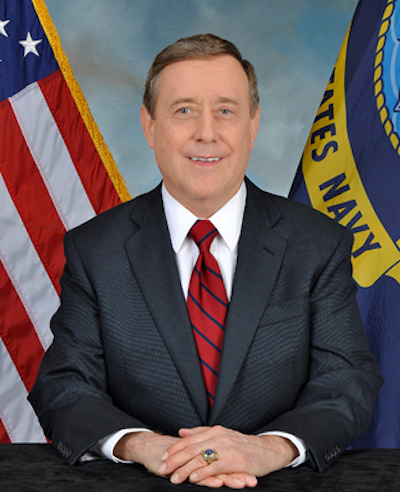
Retired Vice Adm. Ronald A. Route came to the appointment as President, Naval Postgraduate School with over twenty years of leadership experience at the senior executive and operational level, which included responsibilities in graduate education, program requirements and resources, international affairs, research and development, and ethics.
Route’s significant career assignments include President of the Naval War College, and Commander, Navy Warfare Development Command. He also served in two earlier flag officer assignments leading major divisions on the staff of the Chief of Naval Operations (CNO): Director of Navy Programming and Director, Politico-Military Affairs. His Investiture Ceremony was carried out on April 23, 2014.
VADM Janet Tighe (5) 2012-2013
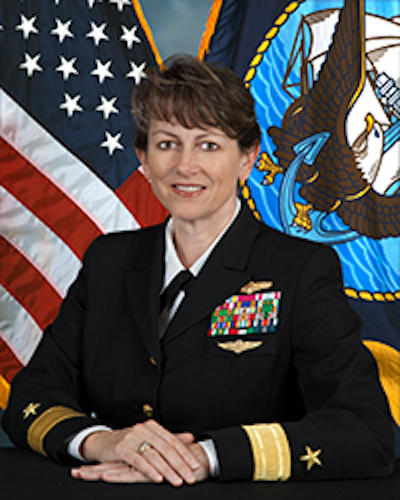
Vice Admiral Jan Tighe was appointed by Secretary of the Navy Ray Mabus to the position of Interim President of the Naval Postgraduate School in Monterey, Calif., in November 2012.
Vice Adm. Tighe has a B.S. in Mathematics from the U.S. Naval Academy, and was commissioned as an ensign (Special Duty Cryptology) in 1984 following graduation. Tighe is also a distinguished graduate of the Naval Postgraduate School, awarded an M.S. in Applied Mathematics as well as a Ph.D. in Electrical Engineering in 2001. She also studied Russian at the Defense Language Institute Foreign Language Center also in Monterey.
VADM Daniel Oliver (Ret.) (5) 2007-2012
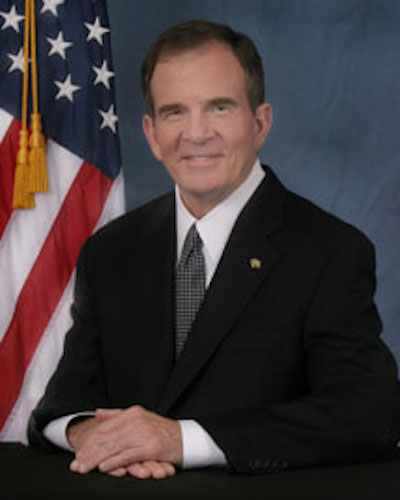 Vice Admiral Daniel T. Oliver USN (Ret.) was appointed by the Secretary of the Navy to be President of the Naval Postgraduate School as of 1 April 2007. Commissioned in 1966 through the Naval Reserve Officer Training Corps program at the University of Virginia, he became a Naval Aviator and piloted the Navy’s P-3 Maritime Patrol Aircraft, specializing in detecting and tracking submarines. He completed eight operational deployments around the world during the Cold War with the Soviet Union, commanding Patrol Squadron Sixteen and Patrol Wing Two. As a Flag Officer, he served as Commander, Fleet Air Forces Mediterranean, and commanded coalition air operations in support of the United Nations’ embargo of the former Republic of Yugoslavia.
Vice Admiral Daniel T. Oliver USN (Ret.) was appointed by the Secretary of the Navy to be President of the Naval Postgraduate School as of 1 April 2007. Commissioned in 1966 through the Naval Reserve Officer Training Corps program at the University of Virginia, he became a Naval Aviator and piloted the Navy’s P-3 Maritime Patrol Aircraft, specializing in detecting and tracking submarines. He completed eight operational deployments around the world during the Cold War with the Soviet Union, commanding Patrol Squadron Sixteen and Patrol Wing Two. As a Flag Officer, he served as Commander, Fleet Air Forces Mediterranean, and commanded coalition air operations in support of the United Nations’ embargo of the former Republic of Yugoslavia.
Vice Admiral Oliver served on the personal staffs of two Chiefs of Naval Operation. In his first Flag assignment as director, Total Forces Training and Education Division, he supervised mobilization of naval reservists called to active duty during Operation Desert Storm. He later served sequentially as director of the OPNAV Assessment Division, Fleet Liaison Division and Programming Division. In these capacities, he was instrumental in shaping a balanced investment program for all Navy resources during the post-Cold War drawdown.
In September 1996, Vice Admiral Oliver became the Chief of Naval Personnel and Deputy Chief of Naval Operations for Manpower and Personnel. He was the primary advocate for sailors, both officer and enlisted, from recruitment through retirement. In this position, he formulated and instituted personnel policies that guided the Navy through a critical transition from a post-Cold War drawdown to a steady state force.
After retiring from active duty in February 2000, he was active in the private sector as a senior executive and board member of a number of companies and civic organizations, mostly involved with government contracting in the Information Technology sector.
Vice Admiral Oliver holds a Bachelor’s and a Master’s degree from the University of Virginia where he also served as an associate professor of Naval Science. Vice Admiral Oliver is a graduate of the Harvard Business School Advanced Management Program and was a White House Fellow.
Dr. Leonard Ferrari, Acting (5) 2007-2007
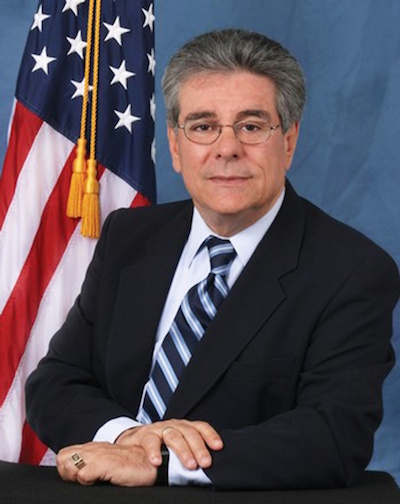
Dr. Leonard A. Ferrari was appointed Executive Vice President and Provost of the Naval Postgraduate School (NPS) in July 2006. Upon assuming the post of Provost, Dr. Ferrari spearheaded a new Strategic Plan initiative, proposed new collaborative efforts with regional research and education institutions and launched new efforts to make campus academic and business processes more effective.
Previously, Dr. Ferrari was the Dean of Research at NPS with responsibility for oversight of research, grants and contracts, the research activities of the Modeling, Virtual Environments, & Simulations Institute (MOVES), the Cebrowski and Meyer Institutes, policy issues and supervision of sponsored programs, oversight of the NPS Research Initiation Program (RIP) and the development of new research relationships and programs with federal, state and civilian organizations. Under his leadership, sponsored programs grew at a rate of nearly 25% per year. Dr. Ferrari played a lead role in the development of industry and relations with the UC system and several universities in the Washington Capital Region (WCR) as well as strengthened programs and collaborations with Lawrence Livermore National Laboratories.
Dr. Ferrari published approximately 100 research articles in electrical engineering and spent thirty years in academic faculty positions in addition to more than ten years in industrial research and development positions. He was Department Head of the Bradley Department of Electrical and Computer Engineering and later Vice Provost for Special Initiatives and Executive Director of the Institute for Information Technology at Virginia Tech. Prior to that time, he was a faculty member at the University of California, Irvine and Associate Dean for Research and Graduate Studies for the School of Engineering. Dr. Ferrari came to NPS with more than ten years of experience in private industry with Bell & Howell and the Polaroid Corporation.
He holds a B.S.E.E. degree from the Massachusetts Institute of Technology and an M.S.E.E. from Northeastern University. His Ph.D. degree is from the University of California, Irvine with research work in spatially varying digital filters. Dr. Ferrari's research is in the areas of signal and image processing, medical imaging systems, computer graphics and multi-media systems. His most recent research was in the area of spline computations for computer graphics and data compression, where he produced extremely efficient computational procedures. He created the 2-5-2 spline, a mathematical basis function suitable for all spline applications that has superior properties and computational advantages over conventional B-splines. Dr. Ferrari and his colleagues have used the new spline algorithms and concepts in the development of low power circuits for high quality computer graphics and data compression in multimedia systems.
COL David Smarsh, Acting (5) 2006-2006
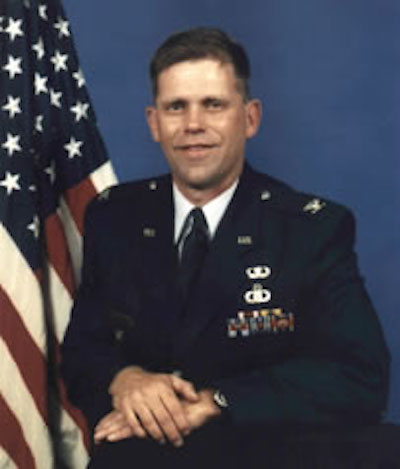
Colonel Smarsh became the Acting President and Chief of Staff of the Naval Postgraduate School in 2006.
He was commissioned in the Air Force following his graduation from Officer Training School in 1979. His career has encompassed a range of command, staff, and operational assignments.
COL Smarsh commanded at the flight, detachment and squadron levels. As the commander of the 88th Weather Squadron, his unit solved acquisition and natural environmental issues for DoD programs including the B-2, F/A-22, C-17, and Missile Program Offices. While commanding the 18th Weather Squadron, his unit provided meteorological support to the XVIII Airborne Corps and the 82d Airborne Division.
His staff experience included serving as the directorate of weather’s chief of plans and deputy for federal and national programs, Headquarters U.S. Air Force. In this position, he coordinated issues between government agencies, DoD, and the intelligence community. His operational experience included providing meteorological support to joint operations and contingencies. He logged 82 jumps during para-weather operations, and he brought meteorological support experience to bombers, fighters, air-lifters, rotary wing aircraft and the space shuttle.
He began his tour at NPS shortly after the Navy school's aeronautical engineering program was transferred to the Air Force Institute of Technology at Wright-Patterson Air Force Base near Dayton, Ohio. NPS gained its meteorology program under his guidance, and as a result, an increase in Air Force officer students. He reciefved the Legion of Merit for his work at NPS.
Read an interview with Colonel Smarsh from the Monterey Herald Newspaper.
RDML Richard Wells, Acting (5) 2005-2006

Rear Admiral Robert Wells served as NPS superintendent upon two occasions. This was his second appointment, following RDML Patrick Dunne.
Wells enlisted in the U.S. Navy in 1966. He later was commissioned through Officer Candidate School. He earned a bachelor’s degree in psychology/business, a master’s degree in journalism, and a multidisciplinary Ph.D.
Rear Admiral Wells’ service as an active duty and naval reserve sailor covers more than 33 years. As an enlisted sailor, he served with Naval Security Group. As a junior officer he served at sea in surface warfare as a division officer and as a deep-sea diving and salvage officer. At the rank of commander he joined the public affairs community.
Commanding officer assignments included HCU One-Det. 110, NAVINFO SW, and OI Det. Oklahoma City. Selected for flag rank in 1996, Rear Admiral Wells’ initial flag assignments were Director, Naval Reserve Public Affairs Program and Special Assistant to the Secretary of the Navy. In those capacities, he served stints as acting CHINFO, acting Deputy CHINFO, projects officer for SECNAV, and projects officer for CNO. A collateral duty was Special Assistant to the Superintendent, Naval Postgraduate School.
Rear Admiral Wells also served as Superintendent, Naval Postgraduate School from May 2000 to September 2000. He retired from the Navy in June 2001.
More recently, Wells served as Mayborn Professor of Journalism at the University of North Texas, where he previously served as department chairman. His professional experience includes working in public relations and metropolitan newspapers in various posts. As a professor, he has published and edited books and published articles and given academic presentations. He also serves on the faculty of the Center for Civil-Military Relations at the Naval Postgraduate School and is certified by the state of Texas as a professional mediator.
RDML Patrick Dunne (4) 2004-2005
Rear Admiral Patrick Dunne was a graduate of the NPS Department of Mathematics. Read his thesis, "Second order linear differential equations with 2-point and integral boundary conditions".
RADM David R. Ellison (4) 2000-2004
RADM Richard Wells, Acting (4) 2000-2000

Rear Admiral Richard Wells served as NPS superintendent upon two occasions. This was his first appointment, following RADM Robert C. Chaplin.
Wells enlisted in the U.S. Navy in 1966. He later was commissioned through Officer Candidate School. He earned a bachelor’s degree in psychology/business, a master’s degree in journalism, and a multidisciplinary Ph.D.
Rear Admiral Wells’ service as an active duty and naval reserve sailor covers more than 33 years. As an enlisted sailor, he served with Naval Security Group. As a junior officer he served at sea in surface warfare as a division officer and as a deep-sea diving and salvage officer. At the rank of commander he joined the public affairs community.
Commanding officer assignments include HCU One-Det. 110, NAVINFO SW, and OI Det. Oklahoma City. Selected for flag rank in 1996, Rear Admiral Wells’ initial flag assignments were Director, Naval Reserve Public Affairs Program and Special Assistant to the Secretary of the Navy. In those capacities, he served stints as acting CHINFO, acting Deputy CHINFO, projects officer for SECNAV, and projects officer for CNO. A collateral duty was Special Assistant to the Superintendent, Naval Postgraduate School
Rear Admiral Wells served as Superintendent, Naval Postgraduate School from May 2000 to September 2000. He retired from the Navy in June 2001. He later served the Naval Postgraduate School as superintendent from 2005-2006.
RADM Robert C. Chaplin (4) 1998-2000
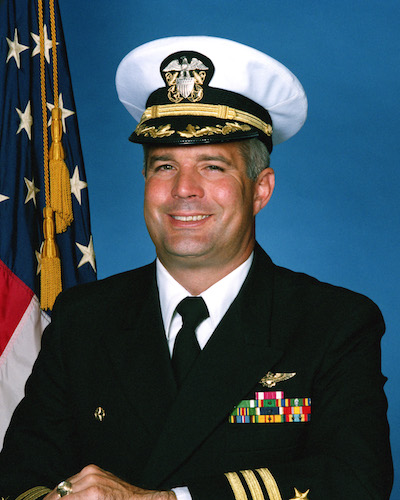
Rear Admiral Robert C. Chaplin was born in Fort Knox, Kentucky and graduated from Fort Knox High School. He attended the United States Naval Academy where he received his commission and Bachelor of Science degree upon graduation in 1970.
Admiral Chaplin was designated a naval aviator in January 1972 and reported to NAS Bermuda. In October 1975, he reported to Helicopter Anti-Submarine Squadron Light (HSL) Thirty-two and served on various detachments and as Officer in Charge aboard USS RICHARD L PAGE (FFG-5).
In January 1979, Admiral Chaplin reported to Naval Postgraduate School, Monterey, California and earned a Master of Science degree in Computer Systems Management. He later reported to HSL-36 in Mayport, Florida and served on various detachments as Officer in Charge. In August 1982,he reported to Commander Seabased Anti-Submarine Warfare Wing Atlantic as the Flag Secretary.
Rear Admiral Chaplin assumed command of USS INCHON (LPH 12) in September 1991. In June 1993, he assumed command of USS WASP (LHD 1) while the ship was deployed to the Persian Gulf. He participated in Operations RESTORE and CONTINUE HOPE off the coast of Somalia and Operations SUPPORT and UPHOLD DEMOCRACY off the coast of Haiti. After this tour, he was appointed Director, Plans and Policy, U.S. Transportation Command, Scott Air Force Base, Illinois. In July 1996, Rear Admiral Chaplin was promoted to Flag Rank and in November reported as Commander, Amphibious Force, U.S. SEVENTH FLEET. In March.1998 Admiral Chaplin received his second star and became the Superintendent of the Naval Postgraduate School.
Rear Admiral Chaplin's personal awards includes the Defense Superior Service Medal, Legion of Merit (with two Gold Star), the Meritorious Service Medal (with three Gold Stars), Navy Commendation Medal, and various campaign and unit awards.
CAPT James M. Burin, Acting (4) 1997-1998
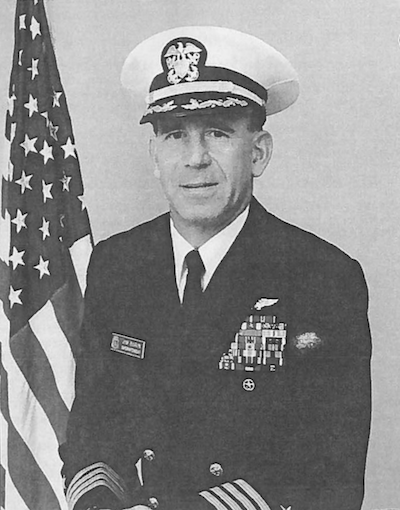 Captain James M. Burin was born in Red Bank, New Jersey, the son of Mr. and Mrs. Charles Burin. He graduated from Dartmouth College and received his commission through the NROTC program in 1967. He was designated a Naval Flight Officer in February 1969.
Captain James M. Burin was born in Red Bank, New Jersey, the son of Mr. and Mrs. Charles Burin. He graduated from Dartmouth College and received his commission through the NROTC program in 1967. He was designated a Naval Flight Officer in February 1969.
After completing A-6 replacement bombardier/navigator training with VA-42 he was assigned to the "Tigers" of VA-65 in September 1969. He made two cruises to the Mediterranean and North Atlantic with VA-65 aboard USS INDEPENDENCE. In January 1972 Captain Burin received orders to the Naval Postgraduate School in Monterey, California. He graduated in September 1974 with a Master of Science degree with distinction in Operations Research.
In June 1991 he was assigned to OPNAV as the Director, Space and Electronic Combat Division. In August of 1992 he became a member of the CNO's Strategic Studies Group. After completing his fellowship, Captain Burin was assigned as the Deputy Joint Forces Air Component Commander and Senior Naval Advisor for Bosnian air operations. He then became the Head, Aviation Plans, Analysis, and Assessments Division for the Director, Naval Air Warfare. In July of 1995 Captain Burin reported to the Naval Postgraduate School to serve as the Director, School of Aviation and Safety.
Captain Burin's decorations include two Legions of Merit, a Bronze Star (with combat "V"), a Defense Meritorious Service Medal, two Meritorious Service Medals, two individual and three Strike/flight Air Medals, two Navy Commendation Medals (with combat "V"), and various other unit and national campaign awards.
RADM Marsha Johnson Evans (4) 1995-1997
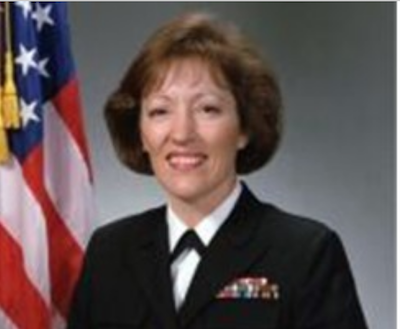 A native of Springfield, Illinois, Rear Admiral Marsha Johnson Evans graduated with high honors from Occidental College in June 1968. Two months later she was commissioned an Ensign at Women's Officer School, Newport, Rhode Island. Early assignments included duty at the Defense Intelligence Agency, on the Commander, Fleet Air Western Pacific staff in Atsugi, Japan, and in the Office of the Chief of Naval Operations (OP-04). In 1973, she became the first woman Surface Assignments Officer in the Bureau of Naval Personnel. Concurrently, she served as Senior Social Aide to the President.
A native of Springfield, Illinois, Rear Admiral Marsha Johnson Evans graduated with high honors from Occidental College in June 1968. Two months later she was commissioned an Ensign at Women's Officer School, Newport, Rhode Island. Early assignments included duty at the Defense Intelligence Agency, on the Commander, Fleet Air Western Pacific staff in Atsugi, Japan, and in the Office of the Chief of Naval Operations (OP-04). In 1973, she became the first woman Surface Assignments Officer in the Bureau of Naval Personnel. Concurrently, she served as Senior Social Aide to the President.
Following selection as a Chief of Naval Operations Scholar in 1975, Rear Admiral Evans earned a Master's Degree in Law and Diplomacy at the Fletcher School of Law and Diplomacy, Tufts University. Subsequently, she served as the Middle East Policy Officer on the staff of the Commander in Chief, U.S. Naval Forces Europe. Selected as a White House Fellow in 1979, she served a one year fellowship as Executive Secretary and Special Assistant to the Secretary of the Treasury. In early 1981 she became the Deputy Director of the President's Commission on White House Fellowships.
In 1982, Rear Admiral Evans was assigned as Executive Officer, Recruit Training Command, San Diego, and from 1984 to 1986 as Commanding Officer, Naval Technical Training Center, Treasure Island, San Francisco. She served the next two years as a Battalion Officer at the Naval Academy. During that assignment, she also chaired the Women Midshipmen Study Group, served on the Navy's 1987 Women's Study, and taught classes in international relations.
In 1989, Rear Admiral Evans began a one year assignment as Chief of Staff, Naval Base San Fransisco. On June 15, 1990, she assumed command of Naval Station Treasure Island, San Francisco. In November 1991 she returned to the Naval Academy as Chief of Staff, an assignment that was curtailed in August 1992 when she became the Executive Director of the Standing Committee on Military and Civilian Women in the Department of the Navy. From June 1993 to July 1995, Rear Admiral Evans served as the Commander of the Navy Recruiting Command. Rear Admiral Evans was a graduate of the Naval War College off-campus program and a 1989 graduate of the National War College.
Source: Marsha Evans' Navy biography.
Read the Tribute to RADM Evans by Hon. Sam Farr of California in the House of Representatives here.
RADM Thomas A. Mercer (4) 1993-1995
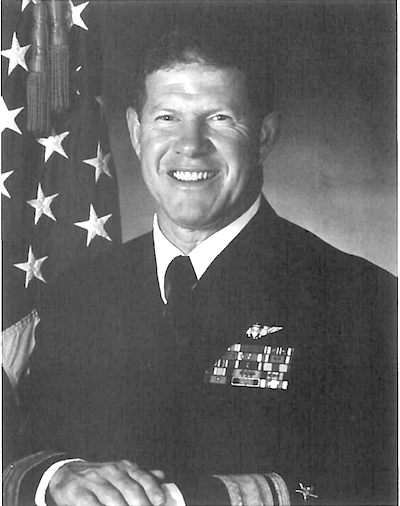 Rear Admiral Thomas A. Mercer was born in Pensacola, Florida, the son of a career naval aviator. He graduated with distinction from the U.S. Naval Academy in 1962 and subsequently completed short tours as an instructor at the Naval Academy and aboard USS RANDOLPH (CVS 15) prior to flight training. He was designated a naval aviator in February 1964. After A-4C training he reported to V A-172 for a three year tour which included two Mediterranean cruises and one Southeast Asia combat deployment aboard USS FRANKLIN D. ROOSEVELT (CVA 42). He then attended the Naval Postgraduate School at Monterey, California and was awarded a Master of Science Degree in Aeronautical Engineering in October 1969. After A-7E training, he reported to V A-195 where he made two combat deployments to Southeast Asia aboard USS KITTY HAWK (CV A 63). Following a shore tour at the Bureau of Naval Personnel, where he served as the Light Attack Placement Officer, he joined VA-82 as Executive Officer in July 1975. He assumed command of VA-82 in November 1976 while embarked aboard USS NIMITZ during her first Mediterranean deployment. Subsequently, he completed nuclear power training at Orlando, Florida, and Idaho Falls, Idaho prior to reporting to the USS ENTERPRISE (CVN 65) in July 1979 as Executive Officer. After a two year tour he assumed command of USS GUADALCANAL (LPH 7) in September 1981.
Rear Admiral Thomas A. Mercer was born in Pensacola, Florida, the son of a career naval aviator. He graduated with distinction from the U.S. Naval Academy in 1962 and subsequently completed short tours as an instructor at the Naval Academy and aboard USS RANDOLPH (CVS 15) prior to flight training. He was designated a naval aviator in February 1964. After A-4C training he reported to V A-172 for a three year tour which included two Mediterranean cruises and one Southeast Asia combat deployment aboard USS FRANKLIN D. ROOSEVELT (CVA 42). He then attended the Naval Postgraduate School at Monterey, California and was awarded a Master of Science Degree in Aeronautical Engineering in October 1969. After A-7E training, he reported to V A-195 where he made two combat deployments to Southeast Asia aboard USS KITTY HAWK (CV A 63). Following a shore tour at the Bureau of Naval Personnel, where he served as the Light Attack Placement Officer, he joined VA-82 as Executive Officer in July 1975. He assumed command of VA-82 in November 1976 while embarked aboard USS NIMITZ during her first Mediterranean deployment. Subsequently, he completed nuclear power training at Orlando, Florida, and Idaho Falls, Idaho prior to reporting to the USS ENTERPRISE (CVN 65) in July 1979 as Executive Officer. After a two year tour he assumed command of USS GUADALCANAL (LPH 7) in September 1981.
In April 1983, Rear Admiral Mercer received additional training at the Division of Naval Reactors prior to assuming command of USS CARL VINSON (CVN 70) in July 1983 as her second commanding officer. During this tour, he completed two WESTPAC/Indian Ocean deployments. In March 1986, he detached from USS CARL VINSON and was promoted to Rear Admiral. He was assigned as Deputy Director for Command, Control, and Communications (J-6), in the organization of the Joint Chiefs of Staff and subsequently became the Vice Director of Operational Plans and Interoperability (J-7 JCS). He assumed Command of Carrier Group 7 in June 1988 and flew his flag in USS NIMITZ (CVN 68) as Commander, Battle Group BRAVO; USS MIDWAY (CV 41) as Commander, Battle Group ALFA; and USS RANGER (CV 61) as Commander, Battle Group ECHO. He assumed duties as CINPACREP Philippines and Commander, U.S. Naval Forces, Philippines in August 1990 and remained in command through the Subic Facility disestablishment on 24 November, 1992. Rear Admiral Mercer's a wards include the Defense Distinguished Service Medal, Defense Superior Service Medal, Legion of Merit (two awards}, Distinguished Flying Cross (three awards}, four individual Air medals, 25 Strike/Flight Air Medals, and six Navy Commendation Medals.
Source: "Rear Admiral Thomas A. Mercer".
RADM Ralph W. West (4) 1989-1993
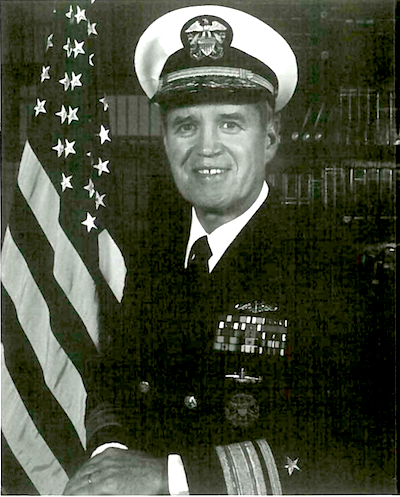
Rear Admiral Ralph W. West, Jr., graduated from the United States Naval Academy in June 1958 and reported to the destroyer USS JONAS INGRAM (DD 938) for his first sea tour. After attending Submarine School and nuclear power training he served on submarines USS TULLIBEE (SSN 597), USS DANIEL WEBSTER (SSBN 626) and USS SKIP JACK (SSN 585). In June 1967, he reported to the staff of Submarine Squadron FOURTEEN at Holy Loch, Scotland for two years as Material Officer. He then served as Executive Officer of USS POGY (SSN 647) commissioning crew.
He commanded USS GURNARD (SSN 662) from May 1973 until May 1976. He subsequently served on the staff of Submarine Group FIVE in San Diego, California until July 1978 when he was assigned as Senior Member, Nuclear Propulsion Examining Board on the staff of Commander in Chief, U.S. Pacific Fleet. He commanded Submarine Squadron FIFTEEN in Guam from June 1980 to June 1981. His next assignments were Assistant Chief of Staff for Logistics and then Chief of Staff to the Commander of the Submarine Force, U.S. Pacific Fleet. After selection to Rear Admiral, he reported in May 1984 as Deputy Director for Operations, National Military Command Center, JCS.
In June 1985, Rear Admiral West assumed command of Submarine Group FIVE in San Diego, California, and in January 1987, he was assigned additional duty as Commander, Submarine Force, U.S. Pacific Fleet. Rear Admiral West next served as Director for Pride, Professionalism and Personal Excellence for the Navy for two years. He assumed duties as Superintendent of the Naval Postgraduate School in July 1989. Rear Admiral West has earned the following medals: Distinguished Service Medal, Defense Superior Service Medal, Legion of Merit (four awards), Meritorious Service Medal (three awards), Navy Commendation Medal (two awards), Navy Achievement Medal, and additional unit and service decorations.
RADM Robert C. Austin (4) 1986-1989
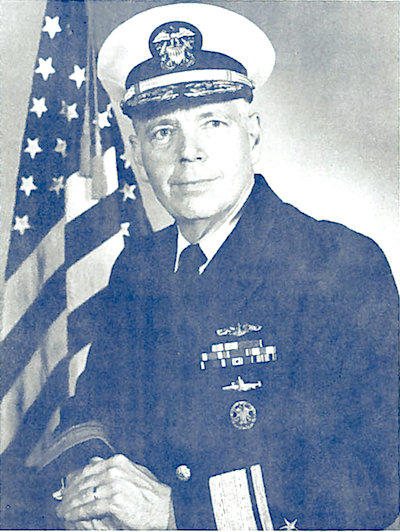 Rear Admiral Austin was born in Cleveland, Ohio on September 5, 1931. After graduating from Maury High School in Norfolk, Virginia, he enlisted in the Navy in October 1948. He obtained a fleet appointment to the Naval Academy.
Rear Admiral Austin was born in Cleveland, Ohio on September 5, 1931. After graduating from Maury High School in Norfolk, Virginia, he enlisted in the Navy in October 1948. He obtained a fleet appointment to the Naval Academy.
Upon graduation from the Naval Academy in 1954, he served on board the USS NOA (DD 841) and was the Engineer Officer upon entering Submarine School in 1957. His first submarine assignment was on the USS THORNBACK (SS 418). In May 1963 he received a Master of Science degree in Physics from the Naval Postgraduate School where he completed an air, space, missile system curricula. He next served as Executive Officer of the USS GRAMPUS (SS 523). He then entered Nuclear Power Training and subsequently served as Navigator aboard the USS TRITON (SSN 586) and as Executive Officer of the USS JOHN ADAMS (SSBN 620) Gold Crew. He was the prospective Commanding Officer during construction and then commanded the USS FINBACK (SSN 670) from 1968 to 1972. He reported to Commander Submarine Force, U.S. Atlantic Fleet as Prospective Commanding Officer Instructor and head of the Advanced Tactical Training Division.
Rear Admiral Austin assumed squadron command of Submarine Development Group 1WO from May 1974 to July 1976. He served as Commanding Officer of the Submarine School from August 1976 until August 1978. He was next assigned as Deputy for Plans and Operations, and then as Chief of Staff of the Submarine Force, U.S. Atlantic Fleet. He was selected for flag rank in January 1980. In July 1980, Rear Admiral Austin reported to the Joint Chiefs of Staff where he served as Deputy Commissioner, U.S. Component of the US-USSR Standing Consultative Commission and as Deputy Director for International Negotiations of the Plans and Policy Directorate. Following his assignment on the joint staff, he served as Chief of Naval Technical Training headquartered at Millington, Tennessee until he assumed duties as Superintendent of the Naval Postgraduate School in July 1986.
Rear Admiral Austin's decorations include the Defense Superior Service Medal, the Legion of Merit with three gold stars, the Meritorious Service Medal, the Navy Expeditionary Medal, Navy Occupation Service Medal with European Clasp, the Navy Unit Commendation Ribbon, National Defense Service Medal and the Armed Forces Expeditionary Medal.
RADM Robert H. Shumaker (4) 1983-1986
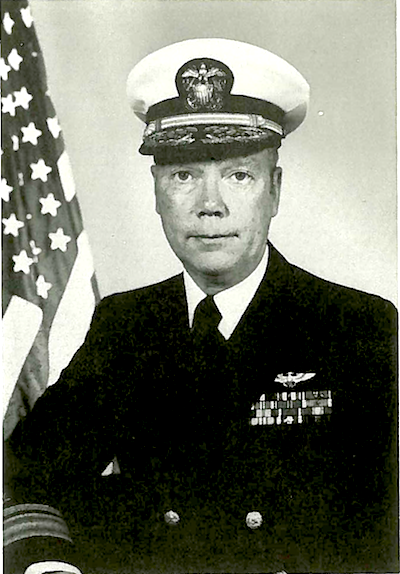 Rear Admiral Robert H. Shumaker was born in New Castle, Pennsylvania where he attended public schools. He graduated from the United States Naval Academy in 1956 where his interests included boxing, cross-country and golf. As a fighter pilot flying the F-8 Crusader, he made several Mediterranean cruises on SARATOGA. In 1964 he earned a Master's Degree in Aeronautical Engineering at the Naval Postgraduate School. In 1965 while serving with VF-154 embarked on USS CORAL SEA, his aircraft was shot down over North Vietnam and he then spent the next eight years as a Prisoner of War. After repatriation he earned a Master's Degree and a Doctor of Philosophy Degree in Electrical Engineering. In 1977 he reported to the Naval Air Systems Command as the logistic commander's executive assistant and then as a major project manager for nine air launched missiles in the defense suppression family. He assumed duties as Superintendent of the Naval Postgraduate School on 21 October 1983.
Rear Admiral Robert H. Shumaker was born in New Castle, Pennsylvania where he attended public schools. He graduated from the United States Naval Academy in 1956 where his interests included boxing, cross-country and golf. As a fighter pilot flying the F-8 Crusader, he made several Mediterranean cruises on SARATOGA. In 1964 he earned a Master's Degree in Aeronautical Engineering at the Naval Postgraduate School. In 1965 while serving with VF-154 embarked on USS CORAL SEA, his aircraft was shot down over North Vietnam and he then spent the next eight years as a Prisoner of War. After repatriation he earned a Master's Degree and a Doctor of Philosophy Degree in Electrical Engineering. In 1977 he reported to the Naval Air Systems Command as the logistic commander's executive assistant and then as a major project manager for nine air launched missiles in the defense suppression family. He assumed duties as Superintendent of the Naval Postgraduate School on 21 October 1983.
The Admiral was awarded the Distinguished Service Medal, two Silver Stars, two Legions of Merit, the Distinguished Flying Cross, Bronze Star, two Purple Hearts, and other awards.
RADM John Joseph Ekelund (4) 1980-1983
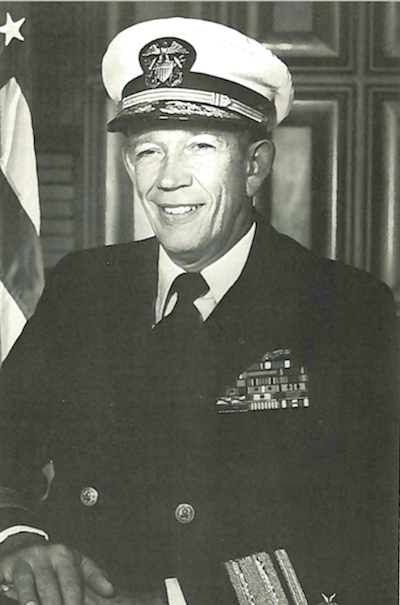 Rear Admiral John Joseph Ekelund graduated from the U.S. Naval Academy in 1949. He is also a graduate of the U.S. Navy's Submarine School, the Armed Forces Staff College, and the University of Rochester where he earned a Master of Science Degree in Systems Analysis.
Rear Admiral John Joseph Ekelund graduated from the U.S. Naval Academy in 1949. He is also a graduate of the U.S. Navy's Submarine School, the Armed Forces Staff College, and the University of Rochester where he earned a Master of Science Degree in Systems Analysis.
After graduating from the Naval Academy, Rear Admiral Ekelund reported to the destroyer escort USS COOLBAUGH (DE 217) as operations officer. After a year in that assignment he reported to the reactivation crew of the USS PIRATE (AM 2 7 5) and served in her until she was sunk while engaged in mine sweeping operations in Wonson, Korea, on 12 October 1950.
Following duty under instruction at submarine school, he reported to duty in USS COBIA (SS 245) as Gunnery Officer. Rear Admiral Ekelund qualified as a Submariner during this tour. He left COBIA in October 1952 and was next involved with the conversion and fitting out of the submarine USS RAZORBACK (SS 394 ). He served aboard RAZORBACK until May of 1955 holding variously the positions of Gunnery, Operations and Engineering officer and Navigator. He was designated Qualified for Command of Submarines during this tour. In June of 1955 Rear Admiral Ekelund joined the staff of Commander Submarine Force, U.S. Pacific Fleet as Assistant Tactics and Training Officer. During his subsequent tour at the U.S. Navy Submarine School, he instructed in Pro-Submarine Tactics and assisted in instruction of the Prospective Commanding Officer course. He also assisted in establishing the Refresher Training and Prospective Executive Officer Courses.
Transferred to Portsmouth Naval Shipyard in 1958, Rear Admiral Ekelund participated in the commissioning and fitting out of the newly constructed guided missile submarine USS GROWLER (SSG 577 ). He served aboard the GROWLER as Navigator, Operations, Engineering and Executive officer. Rear Admiral Ekelund assumed command of the submarine USS GRAYBACK (SSG 574) in November of 1961 and so served until 1964.
Following graduation from the Armed Forces Staff College in August 1964, he was assigned as a member of the Joint Strategic Target Planning Staff where he was a member of both the T aeries and Force Applications Branches.
In 1966 Rear Admiral Ekelund returned to Hawaii as Force Plans Officer, on the staff of the Commander Submarine Force, U .S. Pacific Fleet. Following the receipt of his Masters Degree, he served a short period of temporary duty at the Center for Naval Analysis before reporting in January 1970 to the Office of the Chief of Naval Operations as Head, Strategic Warfare Analysis Branch in the Systems Analysis Division. Rear Admiral Ekelund next assumed the duties as Assistant Chief of Staff for Administration on the combined staff of Commander U.S. Naval Forces and Naval Advisory Group Vietnam.
He became Chief of Staff in November 1972. After completing periods of temporary duty in Hawaii and Washington, Rear Admiral Ekelund assumed command of the guided missile cruiser USS ALBANY (CG 10) in July of 1973. Following command of ALBANY, Rear Admiral Ekelund was assigned to the Naval War College as Dean of Academics. He was selected for Flag rank in January 1976 and in July of that year assumed the duties of Deputy Director of Naval Education and Training. In April 1977 he was assigned to the Central Intelligence Agency as the National Intelligence Officer for General Purpose Forces.
In June 1978 Rear Admiral Ekelund was assigned to duty as U.S. Commander South Atlantic Force, U.S. Atlantic Fleet. He became the Superintendent of the Naval Postgraduate School on 24 January 1980 and President of the California Maritime Academy in Vallejo, California, on 1 November 1983. Rear Admiral Ekelund wore the Legion of Merit, Meritorious Service Medal, Joint Service Commendation Medal and various unit awards and service and campaign medals.
RADM Tyler F. Dedman (4) 1978-1980
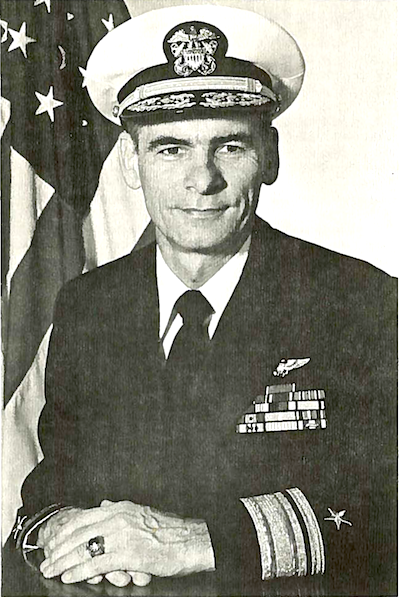 Rear Admiral Tyler Dedman began his naval career in the V-12 program of the U.S. Naval Reserve in 1943 soon after entering the University of California at Los Angeles. He also studied at the University of Kansas and the University of Colorado before entering the U.S. Naval Academy on appointment from his home state of California. He was graduated with distinction on June 6, 1947, was designated Naval Aviator on October 30, 1950, and subsequently advanced in rank to Rear Admiral on July 1, 1972. Rear Admiral Dedman received a degree of Bachelor of Science in Aeronautical Engineering from the Naval Postgraduate School in Monterey, California, and a Master of Science degree in Engineering from Princeton University. He has completed instruction at the Naval War College, Newport, Rhode Island, and has attended the Industrial College of the Armed Forces in Washington, DC.
Rear Admiral Tyler Dedman began his naval career in the V-12 program of the U.S. Naval Reserve in 1943 soon after entering the University of California at Los Angeles. He also studied at the University of Kansas and the University of Colorado before entering the U.S. Naval Academy on appointment from his home state of California. He was graduated with distinction on June 6, 1947, was designated Naval Aviator on October 30, 1950, and subsequently advanced in rank to Rear Admiral on July 1, 1972. Rear Admiral Dedman received a degree of Bachelor of Science in Aeronautical Engineering from the Naval Postgraduate School in Monterey, California, and a Master of Science degree in Engineering from Princeton University. He has completed instruction at the Naval War College, Newport, Rhode Island, and has attended the Industrial College of the Armed Forces in Washington, DC.
Following graduation from the Naval Academy, Rear Admiral Dedman had a varied and demanding career in both fleet and shore assignments. As a junior officer, he served on the USS OAKLAND (CLA-95), on the staff of Commander Naval Forces, Western Pacific and on the USS PASADENA (CL-65). After flight training at tl1e Naval Air Training Command in Pensacola, Florida, he served from June 1951 to June 1954 with Attack Squadron THIRTY-FIVE. While in that assignment, he flew the A-1 Skyraider and participated in several deployments with Air Group THREE, embarked in the USS LEITE (CV-32) to both the Mediterranean and Pacific areas, and joined the USS TARAWA (CV-40) in a round-the-world cruise.
Following studies at the Naval Postgraduate School and Princeton, he joined Heavy Attack Squadron FIVE onboard the attack carrier USS FORRESTAL (CV-59) and served until March 1959 when he tranferred to Heavy Attack Squadron THREE to sene as A3J Project Officer. After the Naval War College he had duty as A-5 Vigilante Project Officer in Attack Design Branch, Bureau of Naval Weapons.
He joined Heavy Attack Squadron ONE HUNDRED TWENTY-THREE for refresher training in A3B aircraft in June 1963 and in November of that year reported as Operations Officer with Heavy Attack Squadron TEN. In that capacity he participated in reconnaissance operations over Laos and Vietnam and in support operations during the Gulf of Tonkin Incident. Rear Admiral Dedman served as Executive Officer of the USS PICKAWAY (APA22), an amphibious troop transport, operating in support of the III Marine Amphibious Force in Vietnam. Upon detachment from the PICKAWAY in August 1967, he reported the next month as Assistant Deputy Director of Navy Program Planning, Office of the Chief of Naval Operations, then worked as Executive Assistant and Senior Aide to the Vice Chief of Naval Operations.
In January 1970 he assumed command of the USS PONCHATOULA (AO148) and in July 1971 became Assistant Vice Chief of Naval Operations and Director of Naval Administration, Office of the Chief of Naval Operations. He was ordered detached in April 1974 for duty as Deputy Chief of Navy Education and Training, Pensacola, Florida. Rear Admiral Dedman became Superintendent of tl1e Naval Postgraduate School, Monterey, California in February 1978.
Rear Admiral Dedman holds the Legion of Merit with Gold Star; the Navy Unit Commendation Ribbon; the American Campaign Medal; World War II Victory Medal; China Service Medal; Navy Occupational Service Medal; European Clasp; National Defense Service Medal with Bronze Star; Korean Service Medal; Armed Forces Expeditionary Medal; Vietnam Service Medal and the United Nations Service Medal. He also has the Republic of Vietnam Campaign Medal with Device.
RADM Isham W. Linder (4) 1974-1978
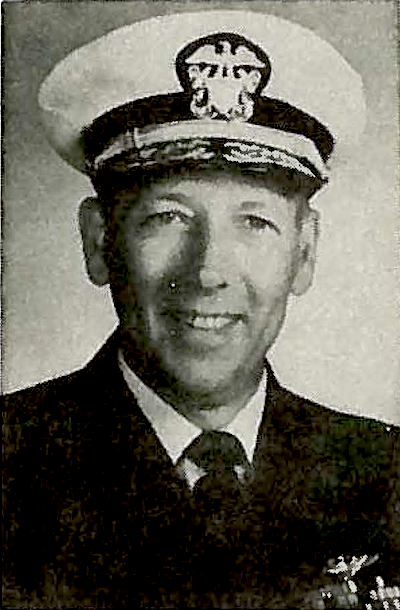 Rear Admiral Isham W. Linder spent most of his younger years in Boulder, Colorado and entered the U.S. Naval Academy, Annapolis, Maryland on appointment by the Secretary of the Navy in 1943.
Rear Admiral Isham W. Linder spent most of his younger years in Boulder, Colorado and entered the U.S. Naval Academy, Annapolis, Maryland on appointment by the Secretary of the Navy in 1943.
Following graduation from the Naval Academy in 1946 he reported on board the USS Springfield (CL-66) then assigned to the Pacific Fleet. Subsequent assignments have included operational naval duties, advanced education, and naval staff posts. A naval aviator, his fleet duties have included assignments with Patrol Squadron 2l in the Atlantic Fleet, on the staff of Commander Amphibious Group 2 also in the Atlantic, and as executive officer and commanding officer of Air Anti-Submarine Squadron 25 with the Pacific Fleet. He has served as Executive Officer of USS Enterprise (CVAN-65) and has commanded USS Cleveland (LPD-7) and USS Intrepid (CVS-11). After promotion to flag rank he was assigned as Commander Cruiser Destroyer Flotilla 2.
Education beyond the Naval Academy has included the Massachusetts Institute of Technology (BS(EE)-1949), the Naval Postgraduate School (MS(EE)-1956) and the University of California at Berkeley (Ph. D. (Eng. Sci.)-1961). He has qualified as a naval nuclear propulsion supervisor by study at the Naval Reactor Training Schools at Mare Island, California and at the National Reactor Testing Station, Idaho.
From 1971-1974 Rear Admiral Linder served in the Office of the Chief of Naval Operations as Head of CVA(N) -Nuclear Powered Aircraft Carrier Coordination. He assumed the post of Superintendent of the Naval Postgraduate School on June 25, 1974.
RADM Mason B. Freeman (4) 1972-1974
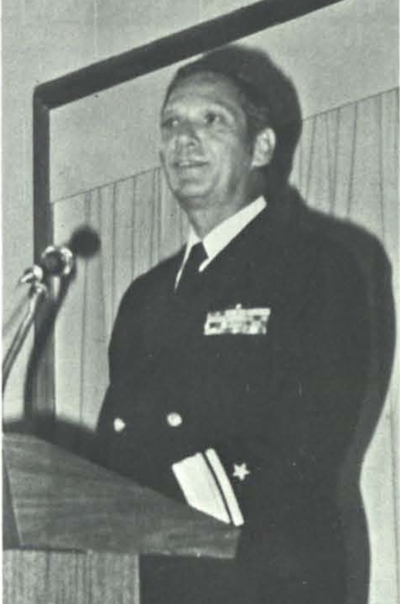 Naval Academy graduate Mason B. Freeman had begun a tour at the Postgraduate School at Annapolis, but found it abbreviated by World War II. He left to join forces in the Pacific in June of 1943.
Naval Academy graduate Mason B. Freeman had begun a tour at the Postgraduate School at Annapolis, but found it abbreviated by World War II. He left to join forces in the Pacific in June of 1943.
RADM Freeman was head of Education and Training in the Bureau of Personnel from 1964 thru 1966, which stimulated an interest in the Naval Postgraduate School.
After a subsequent tour as Commander of Cruiser Destroyer Forces, Pacific, RADM Freeman became director of the Joint Chiefs of Staff in Washington DC. He served as Superintendent of the Naval Postgraduate school March 1972 until June 28, 1974, relieved by RADM Isham W. Linder, USN.
Source: "The Superintendent, Mason B. Freeman, Rear Admiral, U.S. Navy".
RADM Alexander Scott Goodfellow, Jr. (4) 1971-1972
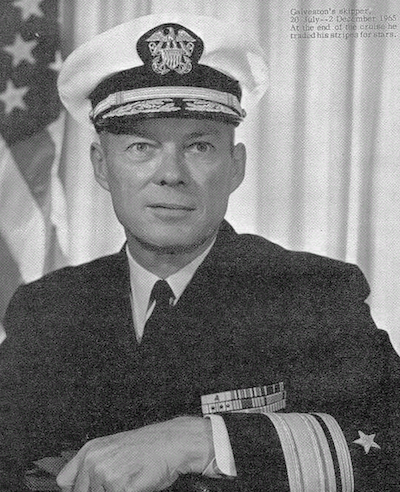 Alexander Scott Goodfellow was born in Seattle, Washington, on February 15, 1917. He was graduated from the Queen Anne High School in Seattle and attended the University of Washington for two years before his appointment to the U. S. Naval Academy in 1936. As a midshipman, he was class president and a member of the golf team. He was graduated from the Naval Academy with the class of 1940 and was commissioned Ensign on June 6, 1940.
Alexander Scott Goodfellow was born in Seattle, Washington, on February 15, 1917. He was graduated from the Queen Anne High School in Seattle and attended the University of Washington for two years before his appointment to the U. S. Naval Academy in 1936. As a midshipman, he was class president and a member of the golf team. He was graduated from the Naval Academy with the class of 1940 and was commissioned Ensign on June 6, 1940.
Following graduation from the Naval Academy, he was assigned to the battleship USS MISSISSIPPI and served in her through most of World War II in the Pacific. During that period, the MISSISSIPPI participated in the Gilbert Islands operation, occupation of Attu, Kwajalein and Majuro Atolls. He next attended the Naval Postgraduate school at Annapolis, Maryland, for one year, then continued his studies at the Massachusetts Institute of Technology, earning a Master of Science Degree in Electrical Engineering. He subsequently advanced in rank to Rear Admiral, donning his two stars on December 2, 1965.
In July 1967, Rear Admiral Goodfellow assumed the duties of Deputy Chief of Naval Material (Development) and Chief of Naval Development with additional duty as Assistant Oceanographer of the Navy for Ocean Engineering and Development and served in these positions until June 1969, and was again awarded a Legion of Merit. At this time he assumed the duties of Commander Operational Test and Evaluation Force in Norfolk, Virginia, and served in that office until April 1971 when he was ordered to assume an assignment as Superintendent, Naval Postgraduate School, Monterey, California.
Rear Admiral Goodfellow held the Legion of Merit with 2 Gold Stars, Bronze Star Medal with Combat "V", Navy Unit Citation, American Defense Service Medal with Bronze "A", European-African-Middle Eastern Campaign Medal, Asiatic-Pacific Campaign Medal with four stars, American Campaign Medal, World War II Victory Medal, China Service Medal, National Defense Service Medal, Korean Service Medal, Vietnamese Navy Distinguished Service Order First Class, Vietnam Service Medal with two campaign stars, United National Service Medal, and the Republic of Vietnam Campaign Medal. He was succeeded at NPS by Rear Admiral Mason Freeman in July, 1972.
RADM Edward J. O'Donnell (4) 1965-1967
In 1965, Rear Adm. E.J. O'Donnell was appointed Superintendent in January 1965, marking the fifth consecutive former NPS student to hold that title.
Source: "Rear Admiral Edward J. O’Donnell, U.S. Navy, Retired".
Read a biographical essay here.
RADM Charles K. Bergin (4) 1963-1964
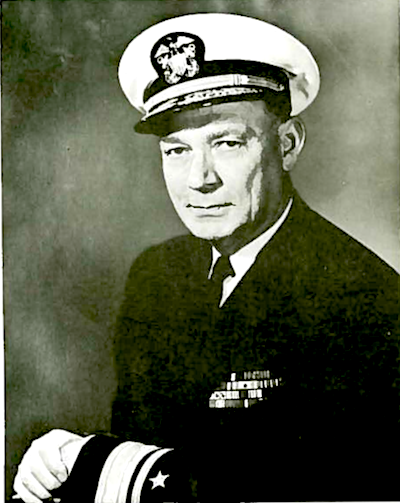 A native of Baltimore, Maryland, Rear Admiral Charles K. Bergin attended Johns Hopkins University before entering the U.S. Naval Academy. After graduating in 1927, he served in the USS MARYLAND and in destroyers, then graduated from the Naval Postgraduate School.
A native of Baltimore, Maryland, Rear Admiral Charles K. Bergin attended Johns Hopkins University before entering the U.S. Naval Academy. After graduating in 1927, he served in the USS MARYLAND and in destroyers, then graduated from the Naval Postgraduate School.
His wartime service included command of the USS MONSSEN in the Saipan invasion and the Leyte landings. He was awarded the Navy Cross for extraordinary heroism during the Battle of Surigao Strait. As Commander Destroyer Division 122 off Okinawa he was awarded the Bronze Star Medal.
After graduating from the Naval War College, he commanded the USS DES MOINES, was Assistant Chief of the Bureau of Ordnance, and served as Commander Destroyer Flotilla THREE and also Commander Destroyer Flotilla ONE.
Following duty in the Office of the Assistant Secretary of Defense, he became Commander Mine Force, U. S. Pacific Fleet.
Admiral Bergin came to Monterey from command of the Operational Test and Evaluation Force with headquarters in Norfolk, Virginia, appointed as Superindendent in August 1963.
Source: O'Connor, Bobbi. "A Hearty Welcome". The Classmate Magazine, September 1963.
RADM Marshall E. Dornin (4) 1961-1963
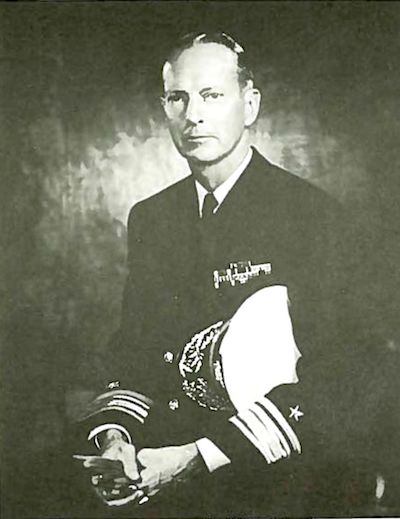
Rear Adm. Marshall E. Domin, former commander of a Pacific Fleet destroyer flotilla, took over the superintendency of the Naval Postgraduate School on Wednesday, 15 March 1961. Adm. Dornin succeeded Capt. Lowell W. Williams, who had held the school's top post since January 13 of that year.
Rear Admiral Marshall E. Dornin, a native of Berkeley, California, graduated from the U.S. Naval Academy in 1930. After serving as a junior officer in battleships and destroyers, he graduated from the then-Postgraduate School at Annapolis, having studied Ordnance Engineering from 1937-1939.
During World War II he commanded the destroyer USS ABBOT in operations in the Pacific, for which he was awarded two Bronze Star Medals and a letter of commendation from the Secretary of the Navy.
Subsequent duties included study at the Naval War College, Assistant Superintendent of the Naval Gun Factory, Naval Liaison Officer to Congress, and command of the cruiser USS DES MOINES.
Admiral Dornin left the Naval Postgraduate School to take command of the Cruiser Destroyer Force, U.S. Pacific Fleet.
Source: "Navy School Head Dornin", Classmate Magazine, April 5, 1961.
RADM Elmer E. Yeomans (4) 1958-1961
Rear Admiral Elmer E. Yeomans was graduated from Linton High School, Linton, Indiana in 1920, and from the US Naval Academy with the degree of Bachelor of Science in 1924. He completed instruction at the Submarine School, New London, Connecticut in 1928; studied Marine Engineering at the Naval Postgraduate School, Annapolis in 1931-32, and received a Master of Science degree from the University of California in 1933. In 1948 he was graduated from the National War College, Washington, DC.
Rear Admiral Yeomans was awarded the Legion of Merit for his service while performing duties as Strategic Planning Officer on the Staff of Commander Submarine Force, Pacific Fleet, from May 1944 to September 1945; and the Bronze Star Medal for Service as Operations Officer for Task Force FORTY TWO from May 1942 to November FIFTY THREE from June 1942 to February 1943.
On 11 January 1954 he assumed command of Cruiser Division FOUR at Boston, Massachusetts, and on 3 June 1955 reported as Deputy Commander, Naval Striking and Support Forces, Southern Europe. He was Superintendent of the US Naval Postgraduate School, Monterey, California, from December 1957 until March 1961, a period during which NPS was again certified by Western Association of Schools and Colleges (WASC), in 1959.
Source: "A Brief Biographical Sketch of Rear Admiral Elmer E. Yeomans, U.S. Navy"
RADM Earl E. Stone (4) 1955-1957
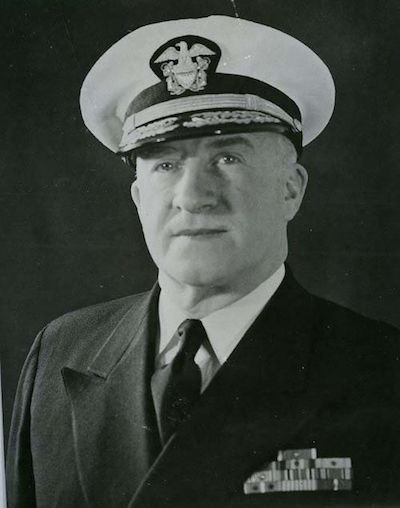
Rear Admiral Earl E. Stone was a Naval Postgraduate School alumnus, the first former student to hold the position of Superintendent. He served as the school’s from December 1955 until December 1957, a period that saw NPS's first women student offers arrive in January 1956.
In February 1941, Stone became the Executive Officer of the USS California; after that ship sank during the Japanese attack on Pearl Harbor, he was named Assistant Director of Naval Communications, Office of the Chief of Naval Operations, Navy Department, an assignment for which he later received a Gold Star in lieu of a second Legion of Merit. He was the first Commanding Officer of the USS Wisconsin, a position he held from April 1944 until February 1945.
In 1949, after a stint as Director of Naval Communications, Admiral Stone became the head of a special committee – later known as the Stone Board – tasked with determining the feasibility of a unified cryptologic agency, and in 1949, he became the first head of the Armed Forces Security Agency (the National Security Agency’s predecessor). He remained in this position until 1951, then served as Director of Communications at the European Command Headquarters between 1952 and 1953 before becoming Commander of Training Command, U.S. Pacific Fleet, a position he held until 1955. Admiral Stone retired in January 1958.
RADM Stone's papers are held by the Dudley Knox Library's Special Collections & Archives. Read the Finding Aid.
RADM Frederick Moosbrugger (4) 1952-1955
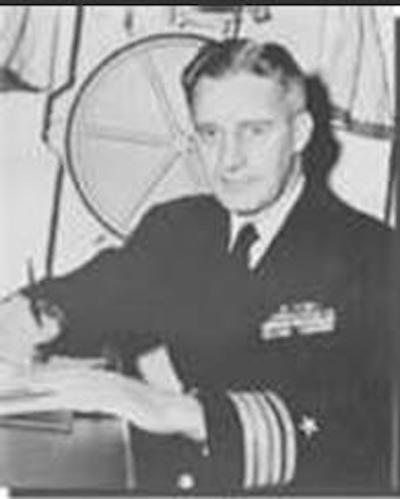 Rear Admiral Frederick Moosbrugger was an NPS alumnus who earned the Navy Cross for his decisive WWII victory in the Battle of Vella Gulf, Solomon Islands. The Navy commissioned a Spruance-class destroyer, the USS Moosbrugger (DD-980), in his honor.
Rear Admiral Frederick Moosbrugger was an NPS alumnus who earned the Navy Cross for his decisive WWII victory in the Battle of Vella Gulf, Solomon Islands. The Navy commissioned a Spruance-class destroyer, the USS Moosbrugger (DD-980), in his honor.
In December 1952, he became Superintendent of the U.S. Naval Postgraduate School, Monterey, the first former NPS student to do so. Under his leadership, NPS was accredited by Western Association of Schools and Colleges, validating the authority of the Superintendent to confer degrees that were acceptable in the academic world.
In December 1955, Moosbrugger reported as Commander Training Command, U.S. Pacific Fleet. He was transferred to the Retired List of the United States Navy on 1 October 1956, and was advanced to the rank of vice admiral.
Source: Naval Postgraduate School Historical Highlights 2012.
RADM Ernest Edward Herrmann (4) 1950-1952
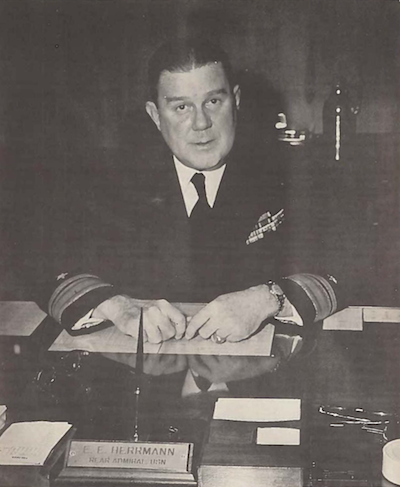 RADM Ernest Edward Herrmann was born July 17, 1896 in New York City. He was appointed to the Naval Academy. entering with the Class of 1919 on July 7, 1915. Due to the approach the first World War, he graduated a year early and was commissioned Ensign on June 6, 1918. Joining the armored cruiser SOUTH DAKOTA, he immediately saw combat service escorting troop convoys to France.
RADM Ernest Edward Herrmann was born July 17, 1896 in New York City. He was appointed to the Naval Academy. entering with the Class of 1919 on July 7, 1915. Due to the approach the first World War, he graduated a year early and was commissioned Ensign on June 6, 1918. Joining the armored cruiser SOUTH DAKOTA, he immediately saw combat service escorting troop convoys to France.
The outbreak of World War II found the then Captain Herrmann acting as Chief Planner and Coordinator for all anti-aircraft material for the Bureau of Ordnance. His performance merited the award of a Gold Star.
When RADM Herrmann became commanding officer of NPS, he was the first flag officer on active duty to hold the position. It was under his supervision that the Naval Postgraduate School was moved from USNA Annapolis to NPS Monterey. On Dec. 22 of that year, NPS began a new phase. In his opening address, Herrmann noted that NPS "was created to foster and encourage a program of research in order to sustain academic excellence."
Herrmann served as Superintendent of the Postgraduate School from June 1950 until his death at NPS on November 19, 1952.
A portrait of RADM Herrmann, commissioned by the NPS community, is today displayed on the Dudley Knox Library's second floor.
The elegant centerpiece of former Hotel Del Monte (today the the administrative offices of the Naval Postgraduate School), was renamed in his honor as Herrmann Hall in 1956.
CAPT Herman Adolf Spanagel (3) 1944-1947
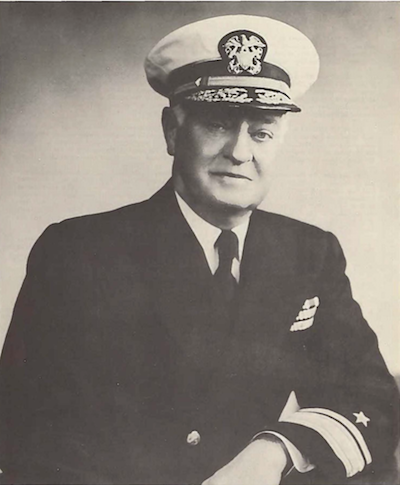
Rear Admiral Herman A. Spanagel acted as Superintendent of the U.S. Naval Postgraduate School from June, 1944, through June, 1960, contributing significantly to the Navy's postgraduate educational program in the period before the move from Annapolis to Monterey.
Herman Adolf Spangel was born in Canton, Ohio, on December 16, 1891. He was appointed to the U.S. Naval Academy in 1910, being graduated and commissioned Ensign on June 6, 1914. After serving in the Battleship SOUTH CAROLINA and a brief tour of duty at the Naval Training Station, Great Lakes, Illinois, he reported as Executive Officer of the destroyer WILKES at Queenstown, Ireland to see active combat service in World War I.
In World War II, he was awarded the Legion of Merit, with Combat "V", for "exceptionally meritorious service as Commanding Officer of the NASHVILLE during action against enemy Japanese forces in the Solomon Islands Area".
He later assumed duty as Head of the Naval Postgraduate School at Annapolis, and three years afterward was designated the first Superintendent of the School, in which capacity he served until June 30, 1950. During this period, he initiated and supported legislative action which culminated in the authorization of the Naval Postgraduate School to award degrees of Master of Science and Doctor of Science, in the establishment of the present school at Monterey, and other legislation for the betterment of the Navy's postgraduate education system. For his long service during his period of expansion of postgraduate curricula, he received a Letter of Commendation from the Secretary of the Navy.
NPS' Spanagel Hall was named in his honor.
Read more about CAPT Spanagel in the Dedication of Buildings document.
Read a biographical essay here.
CAPT Vincent Raphael Murphy (3) 1943-1944
In January 1943 Vice Admiral Murphy was ordered to duty as Head of the Postgraduate School, Annapolis, Maryland, with additional duty as Officer in Charge of Officers of the Chinese Navy under postgraduate instruction at the Naval Academy and at Massachusetts Institute of Technology. He served until July 1944.
Source: Biography of CAPT V.R. Murphy.
CAPT Elwood M. Tillson (3) 1942-1943
Capt. E.M. Tillson was named Acting Head of NPS in November, 1942, serviing until 1943.
Source: Chronological Table of NPS Monterey and Related Activities, 1981, p. 3.
CAPT James Alexander Logan (3) 1940-1942
CAPT James Logan' period as Head of the Postgraduate School spanned the period before Pearl Harbor, as a sense of national emergency was growing. It was during his tenure that the school's curricula was revised to to shorten the time needed to prepare naval officers with necessary technical training.
Source: Root, R.E. "Mathematics and Mechanics in the Postgraduate School at Annapolis", 1943.
CAPT George V. Stewart (3) 1936-1940
Capt. G.V. Stewart replaced Capt. John H. Newton as Head of the Postgraduate School, Annapolis, Maryland, on Sept. 8, 1936.
Source: Chronological Table of NPS Monterey and Related Activities, 1981, p. 2.
CAPT John H. Newton (3) 1933-1936
Capt. J.H. Newton succeeded Frank Sadler as Head of the Postgraduate School, Annapolis, Maryland, on June 8, 1933. He served until June 7, 1937.
Source: Chronological Table of NPS Monterey and Related Activities, 1981, p. 2 and USNA Register, 1936, p. 10.
CAPT Albert T. Church (3) 1927-1931
For the first time since Capt. Ernest King served as Head of NPS, it was an 0-6, Capt. A.T. Church, who read orders to become Head of the Head of the Postgraduate School in Annapolis, Maryland in 1927. In September of that year, a General Line School was established as a one-year course to "acquaint junior line officers, returning from active duty, with modern developments and to broaden their their professional knowledge leading to
future command at sea."
He served until June, 1931, turning over command of NPS to Capt. F.H. Sadler, thus ending what had to date been the longest continuous assignment in that position: three years and nine months.
Source: Chronological Table of NPS Monterey and Related Activities, 1981, p. 2.
LCDR Robert A. Theobald (3) 1924-1927
Born in San Francisco, California, on 30 May 1884, Robert Alfred Theobald attended the University of California in 1902-1903 before entering the United States Naval Academy, from which he graduated ninth in his class in 1907. He was commissioned as an ensign in 1908. His first tour as a commanding officer was of the destroyer USS Walke (DD-34) in 1915.
During World War I, Theobald served as gunnery officer of the battleship USS New York (BB-34), the flagship of Battleship Divistion Nine, which served with the British Grand Fleet in 1917-1918. He received promotion to commander in September 1918.
Theobald served as executive officer of the Naval Postgraduate School from 1919 to 1921, then spent the years 1922 through 1924 serving in Destroyer Command, United States Asiatic Fleet, before returning to the Postgraduate School to serve as its commanding officer from 1924 to 1927. This was the final occasion upon which an officer below O-6 rank was to serve as commanding officer, marking a recommitment to the advanced training of career Naval officers. '
He retired from active service in 1945.
Source: Rilling, Alexander Wolfgang. "The first fifty years of graduate education in the United States Navy 1909-1959".
RADM Albert Miller Penn (3) 1923-1924
In 1923, the Head of the Postgraduate School was vested in then-Lt. Cmdr. A.E. Penn, who replaced a commander. This controversial appointment seemed to signal that the School's significance to the training of Naval officers was diminished in the eyes of leadership, and strong objections came from the Department of the Navy.
Source: Chronological Table of NPS Monterey and Related Activities, 1981, p. 2.
CDR Alexander Sharp, Jr., 1922-1923
CDR Joseph Otto Fisher, Acting (3) 1921-1922
CDR Joseph Otto Fisher, born Mar. 31, 1882, graduated from the Naval Academy's School of Marine Engineering's first graduating class in 1902. After completing his education, he was assigned to USS North Dakota, and was part of Naval Forces in Europe during WWI. He became Acting Head of the School from 1921 until 1922, and retired from service in 1928.
Source: USNA SPCOL Folder No. 2573
CAPT Ernest Joseph King (2), (3) 1919-1921
NPS's King Auditorium is named in honor of Fleet Admiral Ernest Joseph King, United States Navy, who as Head of the USNA Postgraduate Department after World War I built up the school's civilian faculty to strengthen and diversify the naval educational program we recognize today as the Naval Postgraduate School.
During World War I, he had served on the staff of Vice Admiral Henry T. Mayo, the commander of the United States Atlantic Fleet, and when the school was reopened in May 1919, Capt. Ernest J. King was selected as its Head. In 1920, the school was officially renamed the United States Naval Postgraduate School, but remained under command of the USNA Superintendent.
Notably, King later served as Chief of Naval Operations in World War II, and would become a five-star Fleet Admiral. His influence generated strong support for NPS in congress and led to the move to Monterey. King was succeeded by Cmdr. Joseph O. Fisher in 1921.
Source: Chronological Table of NPS Monterey and Related Activities, 1981, p. 1; also Dedication of Buildings
Read the text of the 1929 "Knox-King-Pye" report on "Education in the Navy".
CDR Joseph Leonard Hileman (2) 1918-1919
The name of Commander Joseph L. Hileman appears as "Head of Department" for the Naval Academy's "Post Graduate Department" in its 1918 Annual Register, along with faculty members Leonard E. Doggett and Ralph E. Root, for whom NPS's Root Hall is named.
Source: USNA Register, 1918, p. 26.
CDR Wat Tyler Cluverius (2) 1917-1918
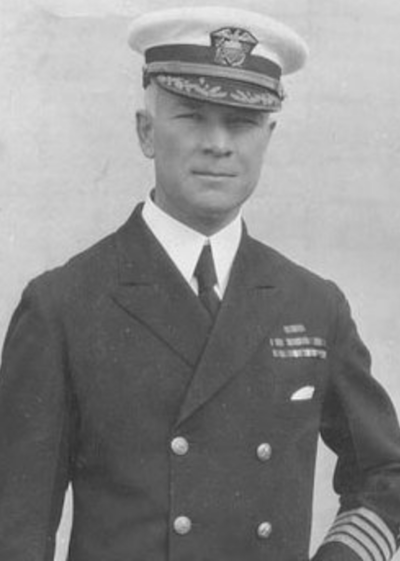
With the end of World War I on Nov. 11, 1918, CDR Cluverius was replaced as Head of NPS by Cmdr. J.H. Hileman.
Source: Chronological Table of NPS Monterey and Related Activities, 1981, p. 1.
LCDR John Halligan (2) 1915-1917
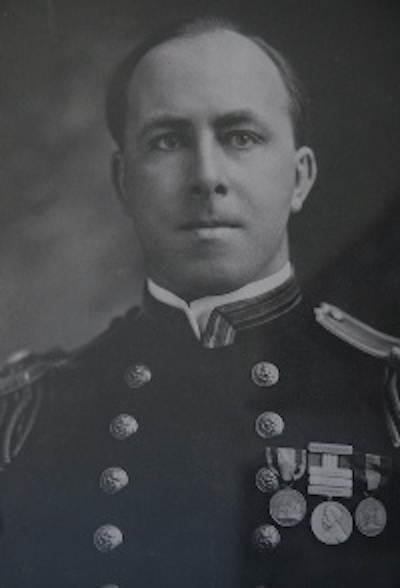 John Halligan was a distinguished officer who as Head of the Postgraduate Department of the Naval Academy was instrumental in advancing the Navy's program of postgraduate education.
John Halligan was a distinguished officer who as Head of the Postgraduate Department of the Naval Academy was instrumental in advancing the Navy's program of postgraduate education.
On March 1, 1915, Capt. L.H. Chandler was named Acting Head of the school, replacing LCDR James P. Morton. Chandler served only until July, when he himself was replaced by Cmdr. L.M. Nulton, also as Acting Head. In September, Cmdr. John Halligan was named Head of NPS. This marks the only time four "commanding officers" served NPS in the same year.
In 1915, under Rear Admiral (then Commander) John Halligan, three new professors and three instructors began to offer courses at the school in Ordnance, Naval Construction Civil Engineering and Marine Engineering.
After entry of the United States into World War I, the Postgraduate Department at Annapolis was closed and the student officers were transferred to combat billets. Halligan went to sea as Aide to the Commander, Patrol Force, Atlantic Fleet.
NPS's Halligan Hall is named in honor of Rear Admiral John Halligan. His successor was Cmdr. W.T. Cluverius.
Source: Chronological Table of NPS Monterey and Related Activities, 1981, p. 1. also Dedication of Buildings
Read more about John Halligan in the 1956 Dedication of Buildings document.
CDR Louis McCoy Nulton (2) 1915-1915
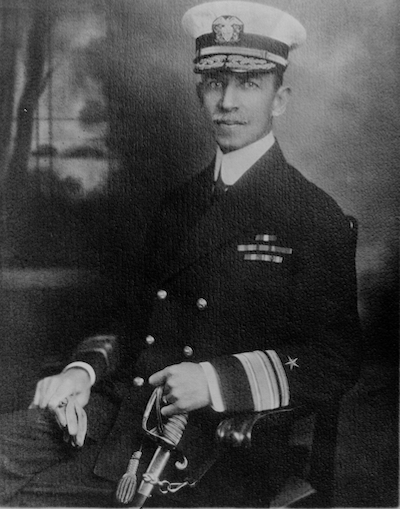 Cdr Louis M. Nulton was appointed as Acting Head of the Naval Postgraduate School in 1915.
Cdr Louis M. Nulton was appointed as Acting Head of the Naval Postgraduate School in 1915.
Source: Chronological Table of NPS Monterey and Related Activities, 1981 p. 1, and Modern Biographical Files in the Navy Department Library: Nulton, Louis McCoy.
CAPT Lloyd Horwitz Chandler (2) 1915-1915
On March 1, 1915, Capt. L.H. Chandler was named Acting Head of the school, replacing LCDR James P. Morton. Chandler served only until July, when he himself was replaced by Cmdr. L.M. Nulton, also as Acting Head. In September, Cmdr. John Halligan was named Head of NPS. This marks the only time four "commanding officers" served NPS in the same year.
In October 1912, General Order 233 called for the renaming of the school to the Postgraduate Department of the United States Naval Academy. The change was made to further "the best needs of the United States Navy."
Source: Chronological Table of NPS Monterey and Related Activities, 1981.
LCDR James P. Morton (2) 1912-1915
On June 3, 1912, Lt. Cmdr. J.P. Morton replaced LCDR Milton E. Reed as Head of NPS, marking the first change of command at the school. Source: Chronological Table of NPS Monterey and Related Activities, 1981, p. 1.
LCDR Milton Eugene Reed 1909-1912
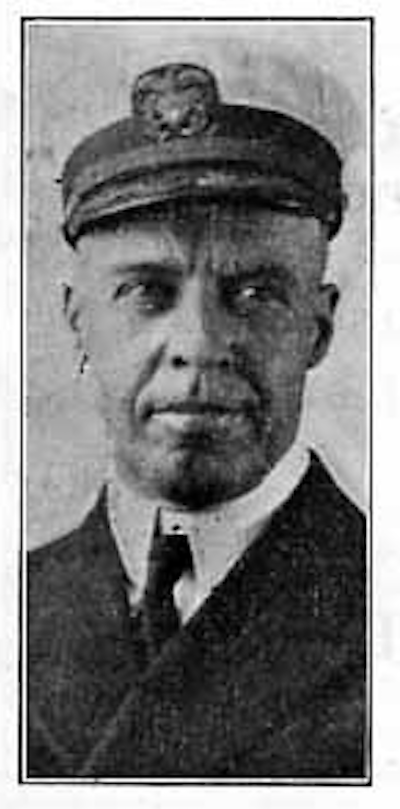 NPS's Reed classroom facility is named in honor of LCDR Milton E. Reed. A graduate of the U.S. Naval Academy class of 1897, he was selected as the first head of the School of Marine Engineering, forerunner of today’s Naval Postgraduate School.
NPS's Reed classroom facility is named in honor of LCDR Milton E. Reed. A graduate of the U.S. Naval Academy class of 1897, he was selected as the first head of the School of Marine Engineering, forerunner of today’s Naval Postgraduate School.
Reed was charged with stimulating interest in engineering matters throughout the Navy and providing competent design engineers for the future in a 2-year program of experimentation, lectures, reading, research and study. "It is not expected not intended by the Navy Department in the preparation of the curriculum for the school, that the forgoing work shall completely cover the postgraduate education to be given the student officers. Ample opportunity is given to them to develop ideas or methods that they may originate or elaborate leading to better efficiency, design, economy, maintenance or operations." (Source: International Marine Engineering, July 1919, p. 281).

